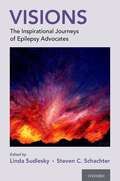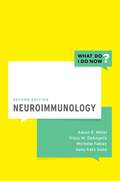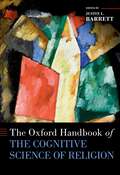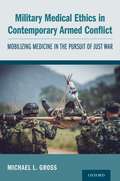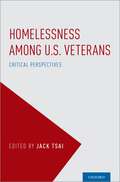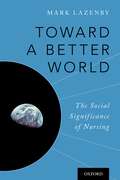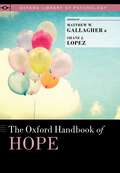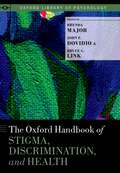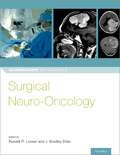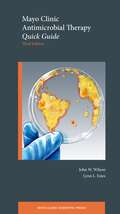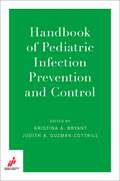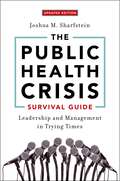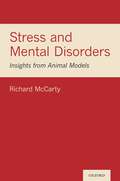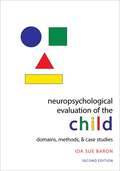- Table View
- List View
Visions: The Inspirational Journeys of Epilepsy Advocates
by Linda Sudlesky and Steven C. SchachterVisions: The Inspirational Journeys of Epilepsy Advocates contains the stories of 50 people who have answered the call to advocate on behalf of those with epilepsy. They are people with epilepsy or members of their community, motivated to make a positive impact through education and awareness, empowerment, fundraising, healthcare and research, and organizational advocacy. Shining a light on well-known issues as well as rare forms of epilepsy and SUDEP (Sudden Unexplained Death in Epilepsy), these advocates depict their journeys through both prose and photographs. Along with stories that depict the advocates' journeys, photographs show these advocates and their work in action. Visions: The Inspirational Journeys of Epilepsy Advocates empowers people affected by epilepsy and inspires continued advocacy for what has been a misunderstood and underfunded neurological disorder.
Neuroimmunology (What Do I Do Now)
by Aaron E. Miller Tracy DeAngelis Michelle Fabian Ilana Katz SandPart of the What Do I Do Now?" series, Neuroimmunology uses a case-based approach to cover common and important topics in the examination, investigation, and management of central and peripheral demyelinating diseases, vasculitis, and other immune system related neurological disorders. Each chapter provides a discussion of the diagnosis, key points to remember, and selected references for further reading. For this new edition, all cases and references have been updated and new cases have been added, including POEMS, CASPR2 Antibody Syndrome, Isaac's Syndrome, Histiocytosis, and Churg-Strauss. Neuroimmunology is an engaging collection of thought-provoking cases which clinicians can utilize when they encounter difficult patients. The volume is also a self-assessment tool that tests the reader's ability to answer the question, "What do I do now?"
Neuroimmunology (What Do I Do Now)
by Aaron E. Miller Tracy DeAngelis Michelle Fabian Ilana Katz SandPart of the What Do I Do Now?" series, Neuroimmunology uses a case-based approach to cover common and important topics in the examination, investigation, and management of central and peripheral demyelinating diseases, vasculitis, and other immune system related neurological disorders. Each chapter provides a discussion of the diagnosis, key points to remember, and selected references for further reading. For this new edition, all cases and references have been updated and new cases have been added, including POEMS, CASPR2 Antibody Syndrome, Isaac's Syndrome, Histiocytosis, and Churg-Strauss. Neuroimmunology is an engaging collection of thought-provoking cases which clinicians can utilize when they encounter difficult patients. The volume is also a self-assessment tool that tests the reader's ability to answer the question, "What do I do now?"
The Oxford Handbook of the Cognitive Science of Religion (Oxford Handbooks)
Why have religious beliefs and behaviors been nearly universal in human societies? What accounts for similarities and differences across time and across cultures? Could the answer lie in the human brain? Scholars in the cognitive science of religion (CSR) believe that it can- the prevalence of religion is a result of the way our minds work. CSR advances in psychology explain various patterns in religious thought and action. This scientific approach has grown rapidly over the past couple of decades. However, it has often been conflated with related subjects such as evolution and neuroscience. CSR is neither: it straddles the line between cognitive sciences and the study of religion. The Oxford Handbook of the Cognitive Science of Religion directly identifies CSR's unique contributions and clarifies its relationship to neighboring disciplines. With contributions from the field's founders and its rising stars, this volume offers a critical overview of more than 25 years of research. From discussions of human nature to the role of ritual, the contributors offer comprehensive and in-depth analysis of key questions in CSR. Readers will have a variety of entry points to truly grasp where CSR has been, where it is, and where it might go.
The Oxford Handbook of the Cognitive Science of Religion (Oxford Handbooks)
by Justin L. BarrettWhy have religious beliefs and behaviors been nearly universal in human societies? What accounts for similarities and differences across time and across cultures? Could the answer lie in the human brain? Scholars in the cognitive science of religion (CSR) believe that it can- the prevalence of religion is a result of the way our minds work. CSR advances in psychology explain various patterns in religious thought and action. This scientific approach has grown rapidly over the past couple of decades. However, it has often been conflated with related subjects such as evolution and neuroscience. CSR is neither: it straddles the line between cognitive sciences and the study of religion. The Oxford Handbook of the Cognitive Science of Religion directly identifies CSR's unique contributions and clarifies its relationship to neighboring disciplines. With contributions from the field's founders and its rising stars, this volume offers a critical overview of more than 25 years of research. From discussions of human nature to the role of ritual, the contributors offer comprehensive and in-depth analysis of key questions in CSR. Readers will have a variety of entry points to truly grasp where CSR has been, where it is, and where it might go.
Military Medical Ethics in Contemporary Armed Conflict: Mobilizing Medicine in the Pursuit of Just War
by Michael L. GrossBeleaguered countries struggling against aggression or powerful nations defending others from brutal regimes mobilize medicine to wage just war. As states funnel medical resources to maintain unit readiness and conserve military capabilities, numerous ethical challenges foreign to peacetime medicine result. Force conservation drives combat hospitals to prioritize warfighter care over all others. Civilians find themselves bereft of medical attention; prison officials force feed hunger-striking detainees; policymakers manage healthcare to win the hearts and minds of local nationals; and scientists develop neuro-technologies or nanosurgery to create super soldiers. When the fighting ends, intractable moral dilemmas rebound. Post-war justice demands enormous investments of time, resources and personnel. But losing interest and no longer zealous, war-weary nations forget their duties to rebuild ravaged countries abroad and rehabilitate their war-torn veterans at home. Addressing these incendiary issues, Military Medical Ethics in Contemporary Armed Conflict integrates the ethics of medicine and the ethics of war. Medical ethics in times of war is not identical to medical ethics in times of peace, but a unique discipline. Without war, there is no military medicine, and without just war there is no military medical ethics. Military Medical Ethics in Contemporary Armed Conflict revises, defends, and rebuts wartime medical practices, just as it lays the moral foundation for casualty care in future conflicts.
Military Medical Ethics in Contemporary Armed Conflict: Mobilizing Medicine in the Pursuit of Just War
by Michael L. GrossBeleaguered countries struggling against aggression or powerful nations defending others from brutal regimes mobilize medicine to wage just war. As states funnel medical resources to maintain unit readiness and conserve military capabilities, numerous ethical challenges foreign to peacetime medicine result. Force conservation drives combat hospitals to prioritize warfighter care over all others. Civilians find themselves bereft of medical attention; prison officials force feed hunger-striking detainees; policymakers manage healthcare to win the hearts and minds of local nationals; and scientists develop neuro-technologies or nanosurgery to create super soldiers. When the fighting ends, intractable moral dilemmas rebound. Post-war justice demands enormous investments of time, resources and personnel. But losing interest and no longer zealous, war-weary nations forget their duties to rebuild ravaged countries abroad and rehabilitate their war-torn veterans at home. Addressing these incendiary issues, Military Medical Ethics in Contemporary Armed Conflict integrates the ethics of medicine and the ethics of war. Medical ethics in times of war is not identical to medical ethics in times of peace, but a unique discipline. Without war, there is no military medicine, and without just war there is no military medical ethics. Military Medical Ethics in Contemporary Armed Conflict revises, defends, and rebuts wartime medical practices, just as it lays the moral foundation for casualty care in future conflicts.
Homelessness Among U.S. Veterans: Critical Perspectives
The challenges facing military veterans who return to civilian life in the United States are persistent and well documented. But for all the political outcry and attempts to improve military members' readjustments, veterans of all service eras face formidable obstacles related to mental health, substance abuse, employment, and -- most damningly -- homelessness. Homelessness Among U.S. Veterans synthesizes the new glut of research on veteran homelessness -- geographic trends, root causes, effective and ineffective interventions to mitigate it -- in a format that provides a needed reference as this public health fight continues to be fought. Codifying the data and research from the U.S. Department of Veterans Affairs (VA) campaign to end veteran homelessness, psychiatrist Jack Tsai links disparate lines of research to produce an advanced and elegant resource on a defining social issue of our time.
Homelessness Among U.S. Veterans: Critical Perspectives
by Jack TsaiThe challenges facing military veterans who return to civilian life in the United States are persistent and well documented. But for all the political outcry and attempts to improve military members' readjustments, veterans of all service eras face formidable obstacles related to mental health, substance abuse, employment, and -- most damningly -- homelessness. Homelessness Among U.S. Veterans synthesizes the new glut of research on veteran homelessness -- geographic trends, root causes, effective and ineffective interventions to mitigate it -- in a format that provides a needed reference as this public health fight continues to be fought. Codifying the data and research from the U.S. Department of Veterans Affairs (VA) campaign to end veteran homelessness, psychiatrist Jack Tsai links disparate lines of research to produce an advanced and elegant resource on a defining social issue of our time.
Toward a Better World: The Social Significance of Nursing
by Mark LazenbyNurses are positioned on healthcare's front line, intimately connected to individuals, families, and communities. How can they leverage this position to work for the common good? In Toward a Better World, Mark Lazenby, a philosopher and a nurse, presents a plan of action. He argues that nurses advance the good society when they fulfill fundamental obligations. Promoting equality, peace and respect, providing assistance and safety, and safeguarding the health of our planet are among these obligations. By acting upon them, nurses become a force for social change in their communities. But through the collective power of more than 20 million nurses worldwide, nurses become a global force for making the world a better place--in the present and for the future. A companion to Caring Matters Most, Lazenby's ethics book, Toward a Better World challenges readers to lead good lives of service to others. This book will invigorate all, nurses and non-nurses alike, who wish to spend their lives making the world a better place.
Toward a Better World: The Social Significance of Nursing
by Mark LazenbyNurses are positioned on healthcare's front line, intimately connected to individuals, families, and communities. How can they leverage this position to work for the common good? In Toward a Better World, Mark Lazenby, a philosopher and a nurse, presents a plan of action. He argues that nurses advance the good society when they fulfill fundamental obligations. Promoting equality, peace and respect, providing assistance and safety, and safeguarding the health of our planet are among these obligations. By acting upon them, nurses become a force for social change in their communities. But through the collective power of more than 20 million nurses worldwide, nurses become a global force for making the world a better place--in the present and for the future. A companion to Caring Matters Most, Lazenby's ethics book, Toward a Better World challenges readers to lead good lives of service to others. This book will invigorate all, nurses and non-nurses alike, who wish to spend their lives making the world a better place.
The Oxford Handbook of Hope (Oxford Library of Psychology)
by Shane J. Lopez Matthew W. GallagherHope has long been a topic of interest for psychologists, philosophers, educators, and physicians. In the past few decades, researchers from various disciplines and from around the world have studied how hope relates to superior academic performance, improved outcomes in the workplace, and improved psychological and physical health in individuals of all ages. Edited by Matthew W. Gallagher and the late Shane J. Lopez, The Oxford Handbook of Hope provides readers with a thorough and comprehensive update on the past 25 years of hope research while simultaneously providing an outline of what leading hope researchers believe the future of this line of research to be. In this extraordinary volume, Gallagher, Lopez, and their expert team of contributors discuss such topics as how best to define hope, how hope is distinguished from related philosophical and psychological constructs, what the current best practices are for measuring and quantifying hope, interventions and strategies for promoting hope across a variety of settings, the impact it has on physical and mental health, and the ways in which hope promotes positive functioning. Throughout its pages, these experts review what is currently known about hope and identify the topics and questions that will help guide the next decade of research ahead.
The Oxford Handbook of Stigma, Discrimination, and Health (Oxford Library of Psychology)
by Brenda Major, John F. Dovidio and Bruce G. LinkStigma leads to poorer health. Edited by Brenda Major, John F. Dovidio, and Bruce G. Link, The Oxford Handbook of Stigma, Discrimination, and Health provides compelling evidence from various disciplines in support of this thesis and explains how and why health disparities exist and persist. Stigmatization involves distinguishing people by a socially conferred "mark," seeing them as deviant, and devaluing and socially excluding them. The core insight of this book is that the social processes of stigma reliably translate into the biology of disease and death. Contributors elucidate this insight by showing exactly how stigma negatively affects health and creates health disparities through multiple mechanisms operating at different levels of influence. Understanding the causes and consequences of health disparities requires a multi-level analysis that considers structural forces, psychological processes, and biological mechanisms. This volume's unique multidisciplinary approach brings together social and health psychologists, sociologists, public health scholars, and medical ethicists to comprehensively assess stigma's impact on health. It goes beyond the common practice of studying one stigmatized group at a time to examine the stigma-health link across multiple stigmatized groups. This broad, multidisciplinary framework not only illuminates the significant effects stigma has when aggregated across the health of many groups but also increases understanding of which stigma processes are general across groups and which are particular to specific groups. Here, a compendium of leading international experts point readers toward potential policy responses and possibilities for intervention as well as to the large gaps in understanding that remain. This book is the definitive source of scholarship on stigma and physical health for established and emerging scholars, practitioners, and students in psychology, sociology, public health, medicine, law, political science, geography, and the allied disciplines.
Surgical Neuro-Oncology (Neurosurgery by Example)
Part of the Neurosurgery by Example series, this volume on surgical neuro-oncology presents exemplary cases in which renowned authors guide readers through the assessment and planning, decision making, surgical procedure, after care, and complication management of common and uncommon disorders. The cases explore a number of different types of nervous systems tumors, including glioblastoma, medulloblastoma, skull tumors, and more. Each chapter also contains 'pivot points' that illuminate changes required to manage patients in alternate or atypical situations, and pearls for accurate diagnosis, successful treatment, and effective complication management. Containing a focused review of medical evidence and expected outcomes, Surgical Neuro-Oncology is appropriate for neurosurgeons who wish to learn more about this subspecialty, and those preparing for the American Board of Neurological Surgery oral examination.
Surgical Neuro-Oncology (Neurosurgery by Example)
by Russell R. Lonser and J. Bradley ElderPart of the Neurosurgery by Example series, this volume on surgical neuro-oncology presents exemplary cases in which renowned authors guide readers through the assessment and planning, decision making, surgical procedure, after care, and complication management of common and uncommon disorders. The cases explore a number of different types of nervous systems tumors, including glioblastoma, medulloblastoma, skull tumors, and more. Each chapter also contains 'pivot points' that illuminate changes required to manage patients in alternate or atypical situations, and pearls for accurate diagnosis, successful treatment, and effective complication management. Containing a focused review of medical evidence and expected outcomes, Surgical Neuro-Oncology is appropriate for neurosurgeons who wish to learn more about this subspecialty, and those preparing for the American Board of Neurological Surgery oral examination.
Mayo Clinic Antimicrobial Therapy: Quick Guide (Mayo Clinic Scientific Press)
by John W. Wilson Lynn L. EstesThe medical management of infectious diseases and antimicrobial therapy can be a daunting task for health care professionals. Infectious diseases experts at Mayo Clinic provide a coordinated, unified approach to infectious disease treatment for the general patient population as well as the complex patients seen at this internationally renowned destination medical center. Over twenty contributors represent the spectrum of infectious disease experience within the Mayo Clinic framework of patient-centered care. Highlights of Mayo Clinic Antimicrobial Therapy: Quick Guide, Third Edition include simplified and thorough drug dosing recommendations for renal function and renal replacement therapies, drugs of choice for specific organisms (including bacteria, fungi, and viruses), and updated and simplified antimicrobial and management recommendations for specific infectious syndromes. New features of the third edition include dosing recommendations for extended infusions and obese and neonatal patient populations and treatment options targeted for hepatitis B and C infections, prosthetic joint infections, post-transplant infections, and infections resulting from bioterrorism. This compact, user-friendly resource brings the specialized knowledge of Mayo Clinic to your fingertips.
Mayo Clinic Antimicrobial Therapy: Quick Guide (Mayo Clinic Scientific Press)
by John W. Wilson Lynn L. EstesThe medical management of infectious diseases and antimicrobial therapy can be a daunting task for health care professionals. Infectious diseases experts at Mayo Clinic provide a coordinated, unified approach to infectious disease treatment for the general patient population as well as the complex patients seen at this internationally renowned destination medical center. Over twenty contributors represent the spectrum of infectious disease experience within the Mayo Clinic framework of patient-centered care. Highlights of Mayo Clinic Antimicrobial Therapy: Quick Guide, Third Edition include simplified and thorough drug dosing recommendations for renal function and renal replacement therapies, drugs of choice for specific organisms (including bacteria, fungi, and viruses), and updated and simplified antimicrobial and management recommendations for specific infectious syndromes. New features of the third edition include dosing recommendations for extended infusions and obese and neonatal patient populations and treatment options targeted for hepatitis B and C infections, prosthetic joint infections, post-transplant infections, and infections resulting from bioterrorism. This compact, user-friendly resource brings the specialized knowledge of Mayo Clinic to your fingertips.
Handbook of Pediatric Infection Prevention and Control
by Pediatric Infectious PidsAN INNOVATIVE AND ESSENTIAL NEW TOOL IN FIGHTING HEALTHCARE-ASSOCIATED INFECTIONS The Handbook of Pediatric Infection Prevention and Control is the most comprehensive, practical resource available on infection prevention across the spectrum of pediatric healthcare settings, including acute care hospitals, ambulatory practices, and long-term care facilities. It addresses the nuances and challenges specific to pediatric infection prevention, providing expert guidance on topics where evidence-based guidelines don't currently exist. Expertly written and exceptionally practical, this handbook is an essential resource for infection preventionists, healthcare epidemiologists, infectious disease fellows, and anyone who provides support for infection-prevention programs in pediatric facilities. *** The Handbook of Pediatric Infection Prevention and Control is a publication of the Pediatric Infectious Diseases Society, the world's largest organization dedicated to the treatment, control, and eradication of infectious diseases that affect children.
Handbook of Pediatric Infection Prevention and Control
by Pediatric Infectious PidsAN INNOVATIVE AND ESSENTIAL NEW TOOL IN FIGHTING HEALTHCARE-ASSOCIATED INFECTIONS The Handbook of Pediatric Infection Prevention and Control is the most comprehensive, practical resource available on infection prevention across the spectrum of pediatric healthcare settings, including acute care hospitals, ambulatory practices, and long-term care facilities. It addresses the nuances and challenges specific to pediatric infection prevention, providing expert guidance on topics where evidence-based guidelines don't currently exist. Expertly written and exceptionally practical, this handbook is an essential resource for infection preventionists, healthcare epidemiologists, infectious disease fellows, and anyone who provides support for infection-prevention programs in pediatric facilities. *** The Handbook of Pediatric Infection Prevention and Control is a publication of the Pediatric Infectious Diseases Society, the world's largest organization dedicated to the treatment, control, and eradication of infectious diseases that affect children.
The Public Health Crisis Survival Guide: Leadership and Management in Trying Times
by Joshua M. SharfsteinFirefighters are taught to battle flames. Police learn to respond quickly to 911 calls. So why are so few health officials prepared for public health crises? The Public Health Crisis Survival Guide is here to help. Whether it's an infectious disease outbreak, a scathing news report, or a sudden budget calamity, this book gives public health readers an honest and practical overview of what to do when things go wrong -- not just to survive, but to lead and thrive in the most difficult circumstances. With examples drawn from history, recent headlines, and the author's own experience at the local, state, and federal levels, this book covers: · how to recognize, manage, and communicate in a crisis · how to pivot from managing a crisis to advocating for long-term policy change that can prevent the crisis from happening again · how to awaken a sense of crisis on a longstanding problem to generate momentum for change · taboo topics, including whether and how to apologize for mistakes Written by a voice of experience, practicality, and good humor, The Public Health Crisis Survival Guide will be a source of enrichment and reassurance for the next generation of public health students and practitioners.
The Public Health Crisis Survival Guide: Leadership and Management in Trying Times
by Joshua M. SharfsteinFirefighters are taught to battle flames. Police learn to respond quickly to 911 calls. So why are so few health officials prepared for public health crises? The Public Health Crisis Survival Guide is here to help. Whether it's an infectious disease outbreak, a scathing news report, or a sudden budget calamity, this book gives public health readers an honest and practical overview of what to do when things go wrong -- not just to survive, but to lead and thrive in the most difficult circumstances. With examples drawn from history, recent headlines, and the author's own experience at the local, state, and federal levels, this book covers: · how to recognize, manage, and communicate in a crisis · how to pivot from managing a crisis to advocating for long-term policy change that can prevent the crisis from happening again · how to awaken a sense of crisis on a longstanding problem to generate momentum for change · taboo topics, including whether and how to apologize for mistakes Written by a voice of experience, practicality, and good humor, The Public Health Crisis Survival Guide will be a source of enrichment and reassurance for the next generation of public health students and practitioners.
Stress and Mental Disorders: Insights from Animal Models
by Richard McCartyStress has been recognized as an important factor in the development or recurrence of various mental disorders, from major depressive disorder to bipolar disorder to anxiety disorders. Stressful stimuli also appear to exert their effects by acting upon individuals with susceptible genotypes. Over the past 50 years, animal models have been developed to study these dynamic interactions between stressful stimuli and genetically susceptible individuals during prenatal and postnatal development and into adulthood. Stress and Mental Disorders: Insights from Animal Models begins with a discussion of the history of psychiatric diagnosis and the recent goal of moving toward precision psychiatry, followed by a review of clinical research on connections between stressful stimuli and the development of psychiatric disorders. Chapters are also included on neuroendocrine, immune, and brain systems involved in responses to stress. Additional chapters focus on the development of animal models in psychiatry and the susceptibility of the developing organism to stressful stimuli. Subsequent chapters are devoted to animal models of specific stress-sensitive psychiatric disorders, including schizophrenia, autism spectrum disorders, bipolar disorder, anxiety disorders, depression, and post-traumatic stress disorder. These chapters also focus on identification of promising molecular targets for development of new drug therapies. The section concludes with a chapter on animal models of resilience to stress-induced behavioral alterations as a newer approach to understanding why some animals are susceptible to stress and others are resilient, even though they are essentially genetically identical. The final chapter discusses how these basic laboratory studies are providing promising leads for future breakthroughs in the diagnosis, treatment, and prevention of mental disorders.
Stress and Mental Disorders: Insights from Animal Models
by Richard McCartyStress has been recognized as an important factor in the development or recurrence of various mental disorders, from major depressive disorder to bipolar disorder to anxiety disorders. Stressful stimuli also appear to exert their effects by acting upon individuals with susceptible genotypes. Over the past 50 years, animal models have been developed to study these dynamic interactions between stressful stimuli and genetically susceptible individuals during prenatal and postnatal development and into adulthood. Stress and Mental Disorders: Insights from Animal Models begins with a discussion of the history of psychiatric diagnosis and the recent goal of moving toward precision psychiatry, followed by a review of clinical research on connections between stressful stimuli and the development of psychiatric disorders. Chapters are also included on neuroendocrine, immune, and brain systems involved in responses to stress. Additional chapters focus on the development of animal models in psychiatry and the susceptibility of the developing organism to stressful stimuli. Subsequent chapters are devoted to animal models of specific stress-sensitive psychiatric disorders, including schizophrenia, autism spectrum disorders, bipolar disorder, anxiety disorders, depression, and post-traumatic stress disorder. These chapters also focus on identification of promising molecular targets for development of new drug therapies. The section concludes with a chapter on animal models of resilience to stress-induced behavioral alterations as a newer approach to understanding why some animals are susceptible to stress and others are resilient, even though they are essentially genetically identical. The final chapter discusses how these basic laboratory studies are providing promising leads for future breakthroughs in the diagnosis, treatment, and prevention of mental disorders.
Neuropsychological Evaluation of the Child: Domains, Methods, & Case Studies
by Ida Sue BaronNeuropsychological Evaluation of the Child: Domains, Methods, and Case Studies, Second Edition, is an updated and expanded desk reference that retains the first edition's organizational structure, strong practical focus, and lifespan developmental perspective. It is a unique compilation of published and unpublished pediatric neuropsychological test normative data that contains extensive discussion of assessment methods and case formulation. Added for the first time are instructive clinical case vignettes that explicate brain-behavior relationships in youth, from preschool-age through adolescence. These cases illustrate immediate and late effects that result from common and rare medical diseases and psychological disorders, and highlight key issues that arise when examining a child's maturational trajectory and brain-behavioral relationships using convergence profile analysis. Part I, Child Neuropsychology: Current Status, contains four introductory chapters regarding definitions, education and training, and professional roles; reasons for referral; typical and atypical brain development; and clinical practice considerations. In Part II, Clinical Issues, discussion covers the procedural steps of neuropsychological assessment, behavioral assessment techniques, observational data, and oral and written communication of results. These chapters are followed in Part III, Domains and Tests, by extended coverage of topics and tests related to the major neuropsychological domains: intelligence, executive function, attention and processing speed, language, motor and sensory-perceptual function, visuoperceptual, visuospatial and visuoconstructional function, and learning and memory. A final chapter addresses deception in childhood, reasons why a child might reduce effort and invalidate assessment, and the use of performance validity tests, symptom validity tests, and embedded validity indicators to assess noncredible effort. Each of the 16 chapters includes definitions, theoretical concepts, models, and assessment techniques that are essential knowledge for clinical and research pediatric neuropsychologists.
Neuropsychological Evaluation of the Child: Domains, Methods, & Case Studies
by Ida Sue BaronNeuropsychological Evaluation of the Child: Domains, Methods, and Case Studies, Second Edition, is an updated and expanded desk reference that retains the first edition's organizational structure, strong practical focus, and lifespan developmental perspective. It is a unique compilation of published and unpublished pediatric neuropsychological test normative data that contains extensive discussion of assessment methods and case formulation. Added for the first time are instructive clinical case vignettes that explicate brain-behavior relationships in youth, from preschool-age through adolescence. These cases illustrate immediate and late effects that result from common and rare medical diseases and psychological disorders, and highlight key issues that arise when examining a child's maturational trajectory and brain-behavioral relationships using convergence profile analysis. Part I, Child Neuropsychology: Current Status, contains four introductory chapters regarding definitions, education and training, and professional roles; reasons for referral; typical and atypical brain development; and clinical practice considerations. In Part II, Clinical Issues, discussion covers the procedural steps of neuropsychological assessment, behavioral assessment techniques, observational data, and oral and written communication of results. These chapters are followed in Part III, Domains and Tests, by extended coverage of topics and tests related to the major neuropsychological domains: intelligence, executive function, attention and processing speed, language, motor and sensory-perceptual function, visuoperceptual, visuospatial and visuoconstructional function, and learning and memory. A final chapter addresses deception in childhood, reasons why a child might reduce effort and invalidate assessment, and the use of performance validity tests, symptom validity tests, and embedded validity indicators to assess noncredible effort. Each of the 16 chapters includes definitions, theoretical concepts, models, and assessment techniques that are essential knowledge for clinical and research pediatric neuropsychologists.
